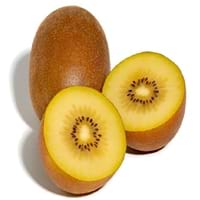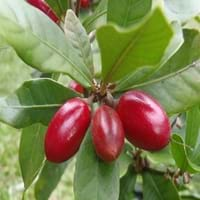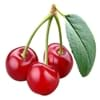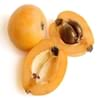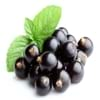Health Benefits
Asthma treatment, Heart care, Improves stomach health, Regulation of heart rate, Treatment of skin Diseases
Good for diabetics, Improves well-being, Miraculin/miracle fruit makes sour things taste sweet
General Benefits
Boosts immune system, Controls blood pressure, Eye care, Helps in weight loss
Has taste modifying effect
Skin Benefits
Brightens and lightens complexion, Heals sunburn, Reduces wrinkles, Skin rejuvenation, Treatment of acne, Treatment of dark spots, Treatment of skin diseases
NA
Hair Benefits
Prevents hair loss, Promotes longer and healthier hair, Treatment of dandruff
NA
Allergy Symptoms
Abdominal pains, Anaphylaxis, Breathing difficulty, Itching in tongue and other parts of mouth, Itching sensation in throat, Swelling of mouth, tongue or lips, Vomiting
Itching, Skin rash
Side Effects
Allergic reaction, Diarrhoea, Skin rash, Possibly unsafe during pregnancy
Changes taste of food eaten after this fruit, Coagulation
Best Time to Eat
Any time except an hour after meal
As a snack in the late afternoon, Eat the fresh ones, avoid mixing with any other foods, don't eat after meal., Morning time (before lunch)
Protein to Carb Ratio
Not Available
Vitamin A (Retinol)
Not Available
Vitamin B1 (Thiamin)
Not Available
Vitamin B2 (Riboflavin)
Not Available
Vitamin B3 (Niacin)
Not Available
Vitamin B5 (Pantothenic Acid)
Not Available
Vitamin B6 (Pyridoxin)
Not Available
Vitamin B9 (Folic acid)
Not Available
Vitamin C (Ascorbic Acid)
Vitamin K (Phyllochinone)
Not Available
Lutein+Zeaxanthin
Not Available
Water Content
Not Available
Calories in Fresh Fruit with Peel
Not Available
Calories in Fresh Fruit without Peel
Not Available
Not Available
Calories in Frozen Form
Not Available
Not Available
Calories in Dried Form
Not Available
Calories in Canned Form
Not Available
Calories in Juice
Not Available
Calories in Jam
Not Available
Calories in Pie
Not Available
Season
Spring, Summer, Winter
Monsoon
Varieties
Qing Yuan #27, Qing Yuan #29, Qing Yuan #6 and Huang Yan
Gymnema Sylvestre and Thaumatococcus Daniellii
Color
Brown, Yellow
Dark red
Inside Color
Yellow
Greyish-white
Soil Type
Well-drained
Well-drained
Climatic Conditions
Cold, Sunny
Rainfall
Facts about
- The name Kiwi is due to its resemblance with 'Kiwi' bird.
- This variety of Kiwi was developed by New Zealand, it is not fuzzy on the outside and it has a taste reminiscent of the mango fruit.
- The name 'Miracle' because of the magical experience you get after eating it.
- When you have lemon after eating this fruit, it tastes sweet as if it is added with sugar.
- It is also used as natural sweetener.
Other Countries
Chile, France, Greece, Iran, Japan, New Zealand, Portugal, Turkey, United States of America
NA
Top Importer
United States of America
Not Available
Top Exporter
New Zealand
United States of America
Botanical Name
Actinidia chinensis
Synsepalum Dulcificum
Synonym
Not Available
Miracle Berry, Miraculous Berry and Sweet Berry
Subkingdom
Tracheobionta
Tracheobionta
Division
Magnoliophyta
NA
Subclass
Dillenhidae
Asteridae
Family
Actinidiaceae
Sapotaceae
Genus
Actinidia
Synsepalum
Species
A. chinensis
S. dulcificum
Generic Group
Kiwi
Not Available
Difference Between Gold Kiwi and Miracle fruit
We might think that Gold Kiwi and Miracle fruit are similar with respect to nutritional value and health benefits. But the nutrient content of both fruits is different. Gold Kiwi and Miracle fruit Facts such as their taste, shape, color, and size are also distinct. The difference between Gold Kiwi and Miracle fruit is explained here.
The amount of calories in 100 gm of fresh Gold Kiwi and Miracle fruit with peel is 60.00 kcal and Not Available and the amount of calories without peel is Not Available and Not Available respectively. Thus, Gold Kiwi and Miracle fruit belong to Low Calorie Fruits and Low Calorie Fruits category.These fruits might or might not differ with respect to their scientific classification. The order of Gold Kiwi and Miracle fruit is Ericales and Ericales respectively. Gold Kiwi belongs to Actinidiaceae family and Miracle fruit belongs to Sapotaceae family. Gold Kiwi belongs to Actinidia genus of A. chinensis species and Miracle fruit belongs to Synsepalum genus of S. dulcificum species. Beings plants, both fruits belong to Plantae Kingdom.
